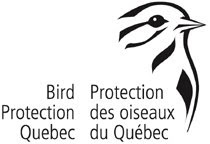Dundee/Ste Martine Field
An "iffy" forecast, high humidity and other commitments limited attendance at yesterday's field trip to southwestern Quebec to 5 birders. We hope that no one got lost because of the detour signs on Route 132 as you approach the Reserve.(For anyone heading down in that direction please note that the "missing" bridge in question is beyond the Fraser Point turn-off for the Reception Centre and therefore you can just ignore the sign and go around it)
Temperatures of 18-24C during the morning seemed reasonable but when combined with the humidity it felt like mid-summer and the birds response or lack thereof echoed that feeling. Things were very slow at Dundee but at least it didn't rain on us.
A walk to the observation tower near the reception centre and beyond produced a scattering of birds but nothing like one would expect during early fall migration. The highlight in this area was a pair of cooperative marsh wrens seen at very close range on the boardwalk. They seemed oblivious to us as they interacted with one singing as if it were spring. They apparently have time management issues!
We birded a section of Fraser Point Road before proceeding to the Great Egret Trail. The highlight here was an immature (juvenile?)bald eagle sitting on a dead tree in the middle of the marsh. Although quite distant, views through the scopes were great.
The group then drove back to the dam at Ste-Martine. Water levels seem to be down from several weeks ago and there are shorebirds present. A young Osprey kept us entertained as it hunted. Although its continual splashing into the water disturbed some of the smaller sandpipers and plovers, the majority just ignored it. The bird was unsuccessful in procuring a meal while we were there.We however managed to spot 7 species of shorebirds along with two Great egrets, a Black-crowned Night-heron and the three probable escapee Graylag geese mentioned on Louise Simard's rare bird website.
Noted by their absence throughout the trip were swallows and warblers. We had none of the former and Common Yellowthroats were our only species of the latter. Our complete list of 46 species included:
Canada Geese - 2, Wood Duck - 6, American Black Duck - 2, Mallard - 100, Green-winged Teal - 10, American Bittern - 1, Great Blue Heron - 3, Great Egret - 2, Green Heron - 7, Black-crowned Night- Heron - 1, Turkey Vultures - 2, Osprey - 1, Bald Eagle - 1, Northern Harrier - 2, American Kestrel - 1, Merlin - 1, Semipalmated Plover - 1, Killdeer - 30, Greater Yellowlegs - 2, Lesser Yellowlegs - 70, Spotted Sandpiper - 2, Semipalmated Sandpiper - 24, Pectoral Sandpiper - 4, Ring-billed Gull - 100, Rock Pigeon - 24, Mourning Doves - 100, Ruby - Throated Hummingbird - 1, Belted Kingfisher - 2, Northern Flicker - 5, Eastern Pheobe - 1, Blue Jay - 24, American Crow 30, Black-capped chickadee - 6, White-breasted nuthatch - 3, Marsh Wren - 2, Veery - 1, Gray Catbird - 2, European Starling - 500+, Cedar Waxwing - 6, Common Yellowthroat - 12, Song Sparrow - 6, Swamp Sparrow - 6, Rose-breasted grosbeak - 2, Bobolink - 1, Red-winged blackbird - 200+, American Goldfinch - 10
Thanks to Sheldon, Darlene, Linda and Lenny for the good company. - W. Grubert
Subscribe to:
Post Comments (Atom)





No comments:
Post a Comment